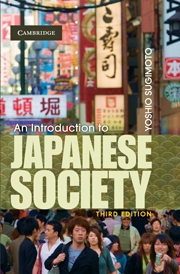Book contents
- Frontmatter
- Contents
- List of Figures
- List of Tables
- Preface to the Third Edition
- Map of Japan
- 1 The Japan Phenomenon and the Social Sciences
- 2 Class and Stratification: An Overview
- 3 Geographical and Generational Variations
- 4 Forms of Work in Cultural Capitalism
- 5 Diversity and Unity in Education
- 6 Gender Stratification and the Family System
- 7 ‘Japaneseness’, Ethnicity, and Minority Groups
- 8 Collusion and Competition in the Establishment
- 9 Popular Culture and Everyday Life
- 10 Civil Society and Friendly Authoritarianism
- References
- Index
10 - Civil Society and Friendly Authoritarianism
- Frontmatter
- Contents
- List of Figures
- List of Tables
- Preface to the Third Edition
- Map of Japan
- 1 The Japan Phenomenon and the Social Sciences
- 2 Class and Stratification: An Overview
- 3 Geographical and Generational Variations
- 4 Forms of Work in Cultural Capitalism
- 5 Diversity and Unity in Education
- 6 Gender Stratification and the Family System
- 7 ‘Japaneseness’, Ethnicity, and Minority Groups
- 8 Collusion and Competition in the Establishment
- 9 Popular Culture and Everyday Life
- 10 Civil Society and Friendly Authoritarianism
- References
- Index
Summary
Two ostensibly contradictory forces operate in Japanese society, as is the case in other industrialized societies. On the one hand, it is subject to many centrifugal forces that tend to diversify its structural arrangements, lifestyles and value orientations. On the other hand, a range of centripetal forces drive Japanese society towards homogeneity and uniformity. This chapter recapitulates these two forces from a slightly different angle. The first half of the chapter will examine the vitality of Japan's civil society as the centrifugal drive, while the second part attempts to locate a variety of forms of control in an analytical framework and summarize their features as the centripetal force of Japanese society.
Civil Society
The liveliness of grassroots culture in Japan, detailed throughout this book, reflects the vitality of its civil society, the sphere of voluntary collective activities carried out with a significant degree of autonomy from the power of the state and the forces of the market. The characteristics of Japan's civil society have been a subject of intense debate in recent years, as the frequency with which media refer to such terms as shimin dantai (civil organization), NPO (Non-Profit Organization), and NGO (Non-Governmental Organization) has surged, pointing to the possibility that new forms of voluntary associations might be emerging.
It is a moot point as to whether increasing media attention reflects an actual expansion of civil activity or media bias in favor of pluralistic descriptions of Japanese society.
- Type
- Chapter
- Information
- An Introduction to Japanese Society , pp. 278 - 304Publisher: Cambridge University PressPrint publication year: 2010



